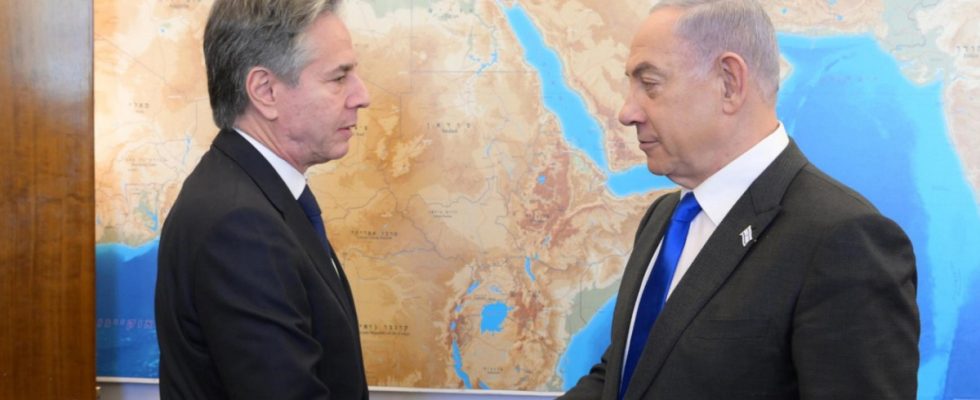A day in the life of the American Secretary of State: Antony Blinken woke up in Saudi Arabia. The day’s program takes him to the Egyptian capital Cairo and Qatar. He finally went to bed in Jerusalem that evening. The war over Gaza is now in its fifth month, and Washington’s chief diplomat is once again tirelessly touring the Middle Eastern crisis area. But wherever he goes, he comes across loose ends – and he has to tie them together to find a solution.
The travel plan reveals that the US government has long since not only kept an eye on the current fighting, but is also pursuing an ambitious overall concept. Of course, the focus is on ending the war over Gaza as quickly as possible. But at the same time, Blinken wants to pave the way for the eventual establishment of a Palestinian state and for long-term reconciliation between Israel and its Arab neighbors. The key to this lies in normalizing relations with Saudi Arabia. After Blinken’s visit to Riyadh, the Saudi leadership committed to this goal, but at the same time underlined the conditions: an Israeli withdrawal from the Gaza Strip and Israel’s commitment to the two-state solution.
First of all, progress is needed in the negotiations about the hostages
So everything is connected to everything else. A great success is possible – or a huge and dangerous failure. What is clear is that the decision will not be made on this fifth trip to the Middle East, which Blinken has undertaken since the war began on October 7th. But at least a start should be made, and this requires progress in the negotiations on a new hostage deal.
A week and a half ago, under American leadership, mediators from Qatar and Egypt presented the basic principles of a new agreement in Paris for the release of the Israelis kidnapped by Hamas to Gaza. Israel’s negotiators immediately signaled their agreement in principle. Finally, on Tuesday evening – just in time for Blinken’s arrival in Qatar and before his talks in Jerusalem on Wednesday – Hamas’ long-delayed response came.
The first finding: There is still a lot of work for Blinken and Co., because Hamas, like Israel, has left a strong “yes, but.” At a joint press conference with Blinken, Qatari Prime Minister Mohammed bin Abdulrahman al-Thani reacted demonstratively optimistically, speaking of a “positive” response from Hamas. In distant Washington, however, US President Joe Biden declared in a much more cautious manner that there was “some movement” but that Hamas’ demands appeared to be “a little exaggerated”. Finally, Blinken pointed out that despite all the difficulties, “an agreement is possible and indeed essential.”
However, Blinken’s task is like squaring the circle, since the ideas of Hamas and the Israeli leadership are still extremely far apart or mutually exclusive on crucial points. The most significant point: Hamas insists that the remaining hostages can only be released if the war for Gaza ends.
Details of Hamas’s response were not officially announced. But the Reuters news agency reports a three-stage plan with reference to a draft it has available. Stretched over 135 days, it is intended to lead from a ceasefire to an end to the war. Accordingly, Hamas proposes to release all women, children, old and sick hostages in an initial phase lasting 45 days in exchange for Palestinian women and children from Israeli custody. During this phase, Israeli troops are expected to withdraw from densely populated areas of the Gaza Strip.
In stage two, also set for 45 days, all remaining hostages can be released – but only if Israel releases a large number of Palestinian prisoners – the number 1,500 is mentioned in the Israeli media – in return. Above all, Israel should commit to a complete end to all hostilities and to completely withdraw its troops from the Gaza Strip. In the final phase, which lasts another 45 days, the remains of the already dead hostages are to be handed over.
The pressure on Netanyahu in Israel is immense
However, Israel’s Prime Minister Benjamin Netanyahu, whom Blinken met in Jerusalem on Wednesday morning, had not missed an opportunity in the past few days to emphasize that for him an end to the war was just as out of the question as the release of “thousands” of prisoners. At a press conference on Wednesday evening, he at least temporarily rejected Hamas’ “delusional demands,” saying they would lead to “disaster.” Instead, he reiterated his mantra that only military pressure and a “complete victory” over Hamas could lead to the hostages’ release.
Blinken’s options for putting pressure on Netanyahu are rather limited. Because concessions to Hamas could cost Israel’s prime minister his office. The right-wing extremist coalition partners categorically reject any far-reaching compromise.
Pressure on Netanyahu over the hostage issue could come solely from Israel’s public. The fate of the abductees is the dominant topic in all debates about the war in the country, and the latest statements by the army spokesman show how time is pressing towards liberation. He now officially declared that 31 of the 136 hostages remaining in Gaza were no longer alive. The New York Times and that Wall Street Journal At the same time, citing anonymous Israeli sources, reported that up to 50 hostages could possibly be dead.
In view of this complicated situation, Blinken alone should see it as positive that, despite the opposing positions, neither side has slammed the door on further negotiations. Despite all the hectic travel diplomacy, his work is still just beginning. There is no sign of a quick solution anywhere, and fighting continues unabated in the Gaza Strip. According to the Palestinian health authorities, more than 27,000 people were killed, two thirds of which were women and children. After four months of war, this is only an interim assessment.

